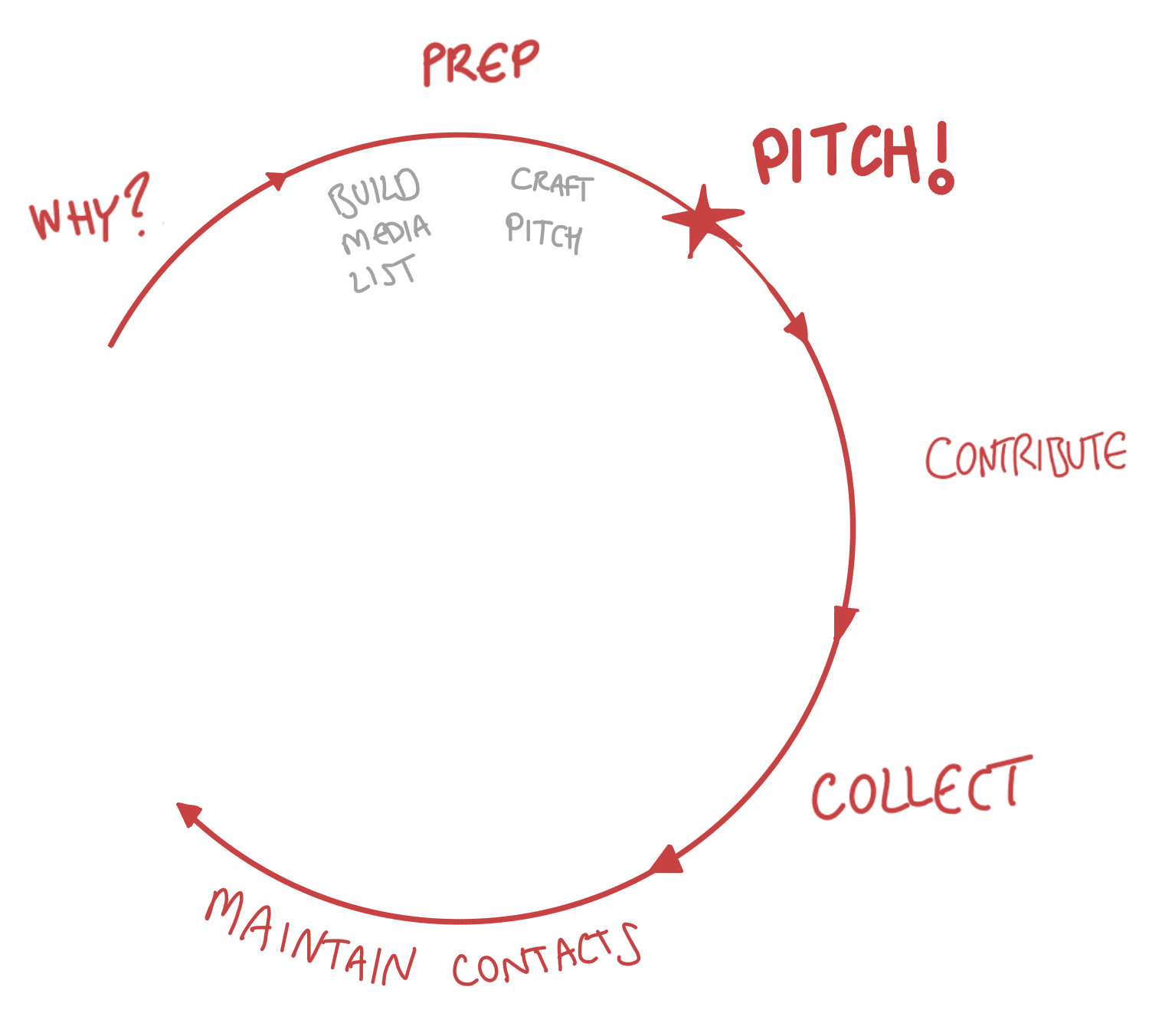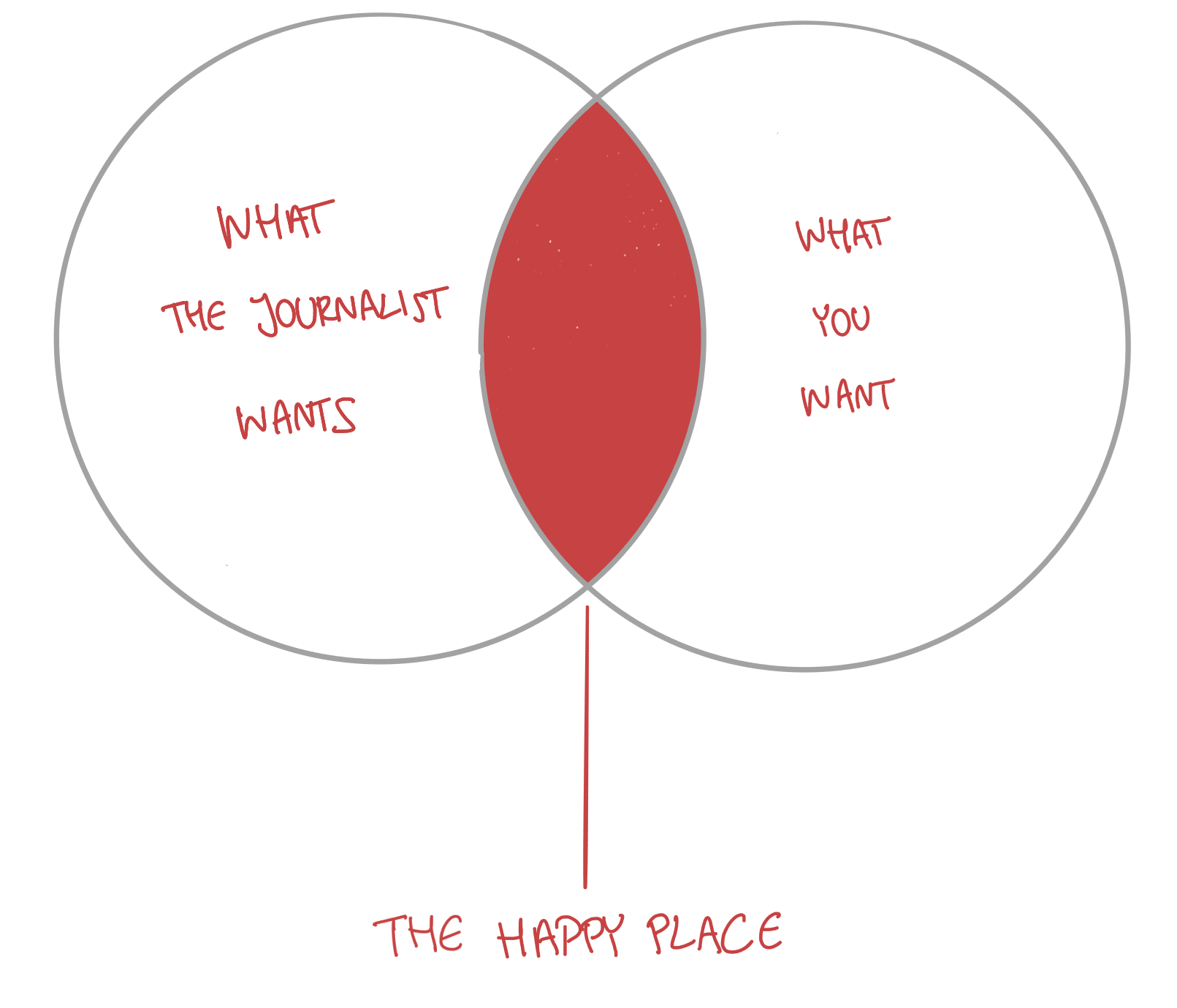If you’re going to confront power, you need to know how to work with media. Whether you're pitching journalists or influencers or anyone with an audience, the mechanics are the same.
So here’s a rough guide to getting coverage for your cause — the smart way.
Before we start,
- This is about proactive media relations. Not sending out press releases, or answering press queries.
- It’s a draft that I will refine over time, so…
- …got suggestions? Get in touch!
OK, here’s the framework:

1. Why?
Media coverage is usually a good thing to have. But never try to develop coverage for the sake of it. Only do so if it directly helps you to achieve your objectives.
For example:
- You’re trying to attract funders for your activist project. You want coverage to show them the project is serious.
- You’re looking for volunteers for your local initiative. You want coverage to reach out to people in your city and let them know.
- You're trying to apply pressure on a politician to take action. You want to use coverage to do this (as we did in our Portugal campaign earlier this year).
Each example above has a target: a potential funder, a potential volunteer, a politician. Now, imagine that person reading an article, or watching a TV news segment. What would they need to see — what headline, what content, in which outlet — to get them to do what you want them to?
That’s the coverage you’re aiming for.
2. Prep
Build media list
Which journalists are writing about your topic — or a topic you can feed into? Who wrote a piece that you wish your cause had been featured in? Who are you going to pitch?
The answers to these questions are what your media list is made of. And a few searches is all you need to get it started.
For example, last year I worked with a group of Bulgarian grassroots activists, to help get their story into foreign outlets. After five minutes of Google News and Twitter searches, we had a list of journalists to pitch who were covering Bulgaria. (Most journalists are on Twitter. Their handles will often be in their bylines; otherwise you can search. You can also use Twitter's private lists to organise them: e.g. by industry – tech, politics, news, etc. -- or location.)
Also, consider the target outlet. Remember that media coverage is just a means to an end, a way to get your messages into your target’s brain. What media are they consuming? Shoot for that.
In our Portugal campaign, for example, we aimed for local and regional press. Because these outlets were most likely to be read by the mayor’s constituents, getting coverage in them was the best way to pressure the mayor to act.
Don’t overthink whether an outlet is friendly or hostile. If your target is consuming media that has a different ideological line to yours, pitch that outlet anyway. Because confronting power sometimes requires infiltrating. And a small mention in an unfriendly outlet that reaches its target, is better than a big splash of coverage in a friendly title that doesn’t.
Lastly, go small. Pick five journalists for your media list and concentrate on those. Research each one, for a few minutes each. I know PRs that still blast out pitches to hundreds of journalists hoping for a hit. They forget the word ‘relations’ in media relations. You need to nurture the relationship.
Craft pitch
Smart media relations is a game of agenda mapping: giving the journalist what they want, in a way that also gives you what you want.

As we said earlier, you’re only doing this because you want to further your objective. So, you need a piece with a headline and content that helps that to happen.
The journalist wants:
- an interesting story that sells
- something packaged and ready, that saves them time and resources (both in short supply for journalists today)
- to create something of value, that will be seen positively by their editors and peers
Your pitch1 is a note to them offering all the above.
For example:
Hi XXX, I’m XXX. XXX [your news] and I thought you might be interested in covering it, since you recently wrote about XXX. You can read about it at XXX and I’d be happy to give your more info if needed.
Keep your pitch loose, and short — something you could insert into a private message on social media. But since you’ve only got five journalists on your list, tailor your pitch to each one, citing what they have written or why you’re pitching them. Nobody likes being cut-and-pasted at.
Remember the journalist wants something packaged and ready. So the more work you can do for them, the better. Imagine you’re a journalist with a publishing deadline. What would make your life easier? That's what your pitch should offer.
If you can offer an interview with an expert related to your project, mention it. Got a selection of spokespeople, demographically diverse? Even better. Got photography that they could use in the piece? Great; let them know in the pitch (don’t attach it). Got fresh research? Link to it.
If you're doing this over email, make sure your signature includes your mobile phone number, social media contacts, and your full name and title. In case the journalist needs to attribute something to you.
PITCH!

Now send the pitch, via email or social media (many journalists keep their direct messages open), whatever works. Ideally, time it towards the beginning of the week, first thing in the morning when journalists are deciding what to cover.
Don’t sit on it. Just get it out.
Don’t be discouraged if there are non-responses. Journalists get dozens of these pitches every day. Send them a follow-up and if there’s no reply, leave them alone this time. They’re not interested. It’s not personal.
Contribute
You got a hit? Great!
The journalist might ask for email comment, or to schedule an interview with whoever you offered up. Now, prepare a few talking points that you’d like to see reproduced in the resulting piece.
Remember the journalist wants an interesting story that sells. What sells? The usuals: drama, humour, sex, violence, emotion. Don’t worry, you can keep it metaphorical: “fiscal waterboarding” and our own “crisis pornography” are two examples from the Greek crisis that stuck.
If you’re doing an interview, record it on your phone in airplane mode for safekeeping — you never know when you may need it. If you’re divulging sensitive information, don’t be afraid to say when something is ‘off the record’. But use this only when you need to.
And ask the journalist when the piece will be published, so you can keep an eye out for it.
Collect

If you managed to contribute to a piece that got published, now it’s time to collect it. Google Alerts can tell you when it’s out. If it’s behind a paywall (grrr), ask the journalist to send you a PDF or a screenshot. If it’s on a website, save it as a PDF or take a screenshot yourself. If it’s video, download it, then upload it to your own account, privately or publicly. In all cases, you want to have a copy in case the coverage gets taken down or moved elsewhere. A link isn't enough.
Be obsessive about hunting down coverage you’ve secured. This is the tangible output of your work.
Is it good coverage? That’s the wrong question. Instead, ask: is it on target? Did it at least reach the people you were aiming for? Did it help you directly to achieve your activist objective?
Catalogue all your coverage in a hit list. And use these hits: put them on your site, social media channels, newsletter, whatever personal outlets your have. Share them with your group or peers. It’s motivating for everyone involved in a project to see it mentioned publicly.
Maintain contacts
For activist citizens aiming for media coverage, building relationships with journalists is vital. Remember, you’re waging an asymmetric battle against power. You don’t have the profile to ensure your every word will get covered, and you’re at a disadvantage being on the outside of power structures looking in.
Not every interaction with a journalist has to end in coverage. In fact in most cases it won’t, and that’s fine. Each interaction, though, is a chance for you to:
- state your case (i.e. provide background to a journalist for future stories)
- sharpen your messages
- strengthen your relationship with a journalist
Your aim is that whenever that journalist is writing on the topics that fall under your radar, they think of you and get in touch for a quote.
So, build that relationship. If the journalist is in town, get drunk with them (or have coffee, in my case). When you have something new or interesting, or high quality information they might not have come across, share it with them.
And always keep agenda mapping in your mind.
Notes
1: I’m talking about sending quick pitches here, not press releases. I find a press release to be yesterday’s tool, a blunt instrument, and many other negatives. But most importantly for us here, we’re doing media relations. That means developing relationships with journalists and collaborating with them on their stories. Not sending out readymade articles en masse, hoping journalists will publish them as-is… which is the essence of a press release.
That said, press releases are still useful today. Most of the coverage in our Portugal campaign originated from a press release my colleague Nadia sent out. I think whether press releases ‘work’ depends on the outlets and the media landscape and the related norms, and Portuguese regional media might be unique. But this is a debate for another time. TL;DR: prefer quick pitches.


